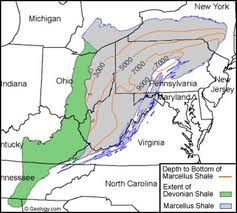The Appalachian Shale Recommended Practices Group (ASRPG), a consortium of 11 of the Appalachian basin’s largest natural gas and oil producers, has prepared recommended standards and practices for exploration and production of natural gas and oil from Appalachian shales. ASRPG said its standards were consistent with the key recommendations of the US Secretary of Energy Advisory Board’s final report and the National Petroleum Council’s Prudent Development Report (OGJ Online, Sept. 16, 2011).
The standards could affect Ordovician, Silurian, and Devonian formations and potentially other formations. The Marcellus shale is a sedimentary rock formation deposited over 350 million years ago. It is a Middle Devonian formation consisting of black, low density, carbonaceous (organic rich) shale. The organic-rich Utica shale is of the Middle Ordovician formation being older, deeper, thicker and more extensive than the Marcellus shale.
The ASRPG plans to submit its recommended standards and practices document to state regulators and legislators in the Appalachian basin, the Interstate Oil & Gas Compact Commission, the State Review of Oil & Natural Gas Environmental Regulations, and various producer organizations.
Companies belonging to ASRPG are Anadarko Petroleum Corp., Cabot Oil & Gas Corp., Chesapeake Energy Corp., Chevron Corp., EQT Corp., Seneca Resources Corp., Shell Oil Co., Southwestern Energy Co., Talisman Energy Inc., WPX Energy Inc., and XTO Energy Inc.
The standards call for preoperational planning to provide communities with information and call upon operators to seek good landowner relations. Operators should evaluate potential water management options before the start of drilling. In addition, operators should consider use of alternative water sources and work with local water boards and other regulatory agencies to identify suitable water sources.
After potential wellpad sites are identified, operators should implement measures designed to reduce the operational footprint. Operators should prepare a regional spill and emergency response plan. Operators also should identify the existence of coal mines or coal seams, depths of useable groundwater, and shallow oil and gas wells within 1,000 ft of the surface location before drilling.
In selecting additives in hydraulic fracturing fluids, operators should strive to minimize the volume and concentration of additives listed on the Material Safety Data Sheet. Operators should design water transfer systems and implement measures to test the integrity of all high-pressure surface equipment.
The process of initiating production should be designed to minimize releases of produced gases and contain produced liquids. Thus, operators should prepare a management plan addressing handling and managing of liquid hydrocarbons when operating in crude, condensate, or wet-gas areas. Also, operators should use a corporate reporting standard, such as the International Petroleum Environmental Conservation Association, for reporting environmental performance metrics.
[Some of us believe that operating standards and best practices should be encoded as required regulations. In this way, the general public can have some confidence that the standards and practices are being followed. Also, in this way there is a so-called “level playing field” to prevent some operating companies from skirting around the standards to gain an unfair advantage over the other companies and over the land owners and the local community. Duane Nichols, www.frackcheckwv.net.]
The Natural Resources Defense Council (NRDC) has recently issued a new report evaluating the wastewater problem in the Marcellus Shale region. This paper analyzes the problem of wastewater generated from the fracking process of producing natural gas, particularly with regard to production in the Marcellus Shale. It shows that hydraulic fracking generates massive amounts of polluted wastewater that threaten the health of our drinking water supplies, rivers, streams, and groundwater; and, that federal and state regulations have not kept up with the dramatic growth in the practice and must be significantly strengthened to reduce the risks of fracking throughout the Marcellus region and elsewhere.

